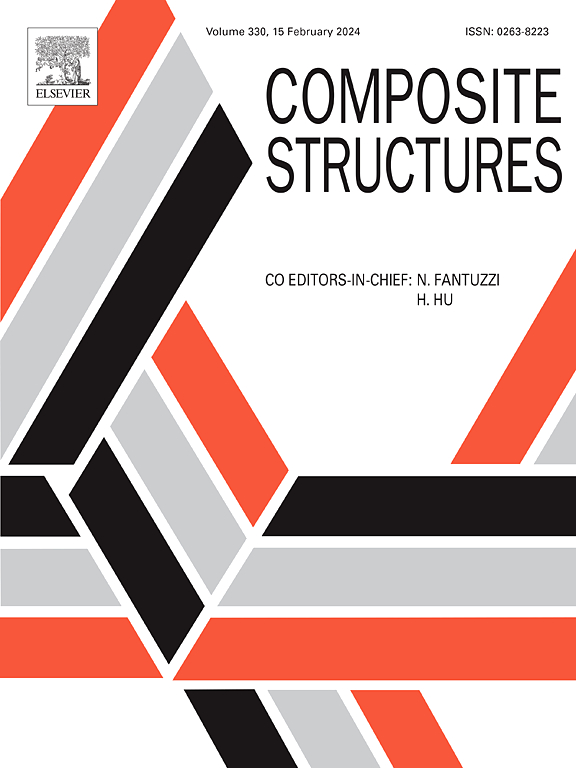Response of fibre metal interpenetrating composite plate under impact loading: Experiment and numerical simulation
IF 6.3
2区 材料科学
Q1 MATERIALS SCIENCE, COMPOSITES
引用次数: 0
Abstract
Fiber Metal Laminates (FML) have excellent mechanical properties and impact resistance, making them widely used in modern engineering fields such as aerospace, vehicle, and shipbuilding. However, the susceptibility to delamination damage is a major disadvantage of FML. In this study, carbon/aramid fibres were combined with a perforated metal matrix in a 3D interpenetrating manner to prepare the Fibre Metal Interpenetrating Composite Plate (FMICP) with excellent interlayer integrity. An impact experiment was carried out on an FMICP sample. Combined with finite element analysis, the analysis was carried out with the aim of investigating the impact response and failure modes of the FMICP, with a focus on analysing the effects of the impact velocity, the area of the impact, and the style of the metal-based perforating on the energy-absorbing capacity of the sample. The results showed that the percentage of impact energy absorbed by different materials was ranked as metal layer, fibre layer, and resin layer. The shape of the perforation in the metal base changed the path and rate of impact stress transfer, with elliptical perforated metal bases having a better rate of energy transfer dissipation as well as energy storage capacity, followed by circular-rectangular, and rectangular being the worst.
金属纤维互穿复合材料板在冲击载荷下的响应:实验与数值模拟
金属纤维层压板(FML)具有优异的力学性能和抗冲击性能,广泛应用于航空航天、汽车、船舶等现代工程领域。然而,易受分层损伤是FML的主要缺点。在这项研究中,碳/芳纶纤维以3D互穿方式与穿孔金属基体结合,制备了具有优异层间完整性的纤维金属互穿复合材料板(FMICP)。对FMICP试样进行了冲击试验。结合有限元分析,对FMICP的冲击响应和破坏模式进行了研究,重点分析了冲击速度、冲击面积和金属基射孔方式对试样吸能能力的影响。结果表明,不同材料对冲击能的吸收比例依次为金属层、纤维层、树脂层。金属基孔的形状改变了冲击应力传递路径和速率,椭圆型金属基孔的能量传递耗散率和能量存储能力较好,圆矩形次之,矩形最差。
本文章由计算机程序翻译,如有差异,请以英文原文为准。
求助全文
约1分钟内获得全文
求助全文
来源期刊

Composite Structures
工程技术-材料科学:复合
CiteScore
12.00
自引率
12.70%
发文量
1246
审稿时长
78 days
期刊介绍:
The past few decades have seen outstanding advances in the use of composite materials in structural applications. There can be little doubt that, within engineering circles, composites have revolutionised traditional design concepts and made possible an unparalleled range of new and exciting possibilities as viable materials for construction. Composite Structures, an International Journal, disseminates knowledge between users, manufacturers, designers and researchers involved in structures or structural components manufactured using composite materials.
The journal publishes papers which contribute to knowledge in the use of composite materials in engineering structures. Papers deal with design, research and development studies, experimental investigations, theoretical analysis and fabrication techniques relevant to the application of composites in load-bearing components for assemblies, ranging from individual components such as plates and shells to complete composite structures.
 求助内容:
求助内容: 应助结果提醒方式:
应助结果提醒方式:


